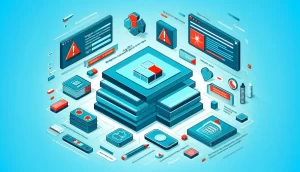Why Software and Data Integrity Failures Are a Critical OWASP Risk in 2025
Software and data integrity failures, identified as A08 in the OWASP Top 10, have rapidly evolved from peripheral concerns to major threats in today’s web ecosystems. Attackers increasingly exploit gaps between secure coding practices and deployment processes, making these failures an urgent issue for both development and security teams.
Understanding Software and Data Integrity Failures
Integrity failures occur when applications consume software components or data that have been tampered with or sourced from untrusted environments. Unlike conventional code-level bugs, these failures stem from flaws in software assembly, delivery pipelines, or runtime trust assumptions.
Common integrity risks include:
- Compromised third-party packages embedded within code.
- Breaches in Continuous Integration/Continuous Deployment (CI/CD) pipelines that alter build artifacts.
- Misconfigurations enabling unauthorized modifications.
- Vulnerabilities in serialization and deserialization processes.
Such issues often go undetected by static analysis tools, as they manifest only during runtime, making dynamic validation essential.
Key CWEs Associated with Software and Data Integrity Risks
Dynamic scanning is especially effective in identifying runtime vulnerabilities related to CWE standards. Notable examples include:
- CWE-502 (Deserialization of Untrusted Data): Malicious payloads injected into deserialization routines can lead to severe execution risks detectable via dynamic behavioral analysis.
- CWE-494 (Download of Code Without Integrity Check): Improper integrity verification allows attackers to introduce unsafe updates, with abnormal runtime behavior detectable through dynamic testing.
- CWE-915 (Improper Modification of Objects): Unauthorized object manipulations often remain hidden until runtime, facilitating privilege escalation or logic corruption.
Why Software Integrity Failures Impact Development and Security Teams Equally
For Developers: Even well-managed development workflows can fall prey to integrity issues. Risks arise from malicious code slipping in via third-party dependencies or pull requests, often unnoticed amidst rapid development cycles. Additionally, compromised build systems may distribute unsafe software versions without source code changes, complicating detection efforts.
For Security Teams: Traditional security tools like Static Application Security Testing (SAST) and Software Composition Analysis (SCA) provide limited visibility into runtime threats, resulting in missed vulnerabilities and alert fatigue. Supply chain attacks, notably increasing in frequency, demand runtime verification to identify executable risks effectively.
A Dynamic Application Security Testing (DAST)-first approach emphasizes examining what software is actually running, providing actionable insights into real exploitable risks.
Real-World Cases Demonstrating the Impact of Integrity Failures
3CX Supply Chain Breach (2023)
The 3CX VoIP application suffered a supply chain attack where a trusted update package was compromised during build and signed for distribution. Tens of thousands of users installed the backdoored version. Source code reviews alone could not have prevented this, but runtime analysis with behavior-based DAST could have detected anomalous activity triggered by the compromised build.
Codecov CI Pipeline Attack (2021)
Attackers injected malicious code into a Bash script utilized within Codecov’s CI workflows to extract credentials. Since the injected code passed through automated pipelines unnoticed for weeks, traditional security controls failed. Validating artifacts at runtime is crucial to prevent these stealthy breaches.
Event-Stream NPM Hijacking (2018)
A popular open-source NPM package, Event-Stream, was hijacked and updated with malicious logic targeting cryptocurrency wallets. The compromised package was downloaded millions of times before detection, highlighting the dangers of trusting external dependencies without continuous monitoring.
The Hidden Threat: Failures Without Functional Errors
One of the most challenging aspects of integrity failures is the lack of observable malfunctions. Applications often continue to operate normally while attackers manipulate logic, leak data, or create unauthorized access under the radar.
Examples include:
- Compromised dependencies quietly sending sensitive telemetry.
- Manipulated update routines adding backdoors.
- Malicious deserialization triggering subtle internal logic changes.
These scenarios evade detection by static tools but surface during runtime, underscoring the importance of dynamic analysis.
The Role of a DAST-First Approach in Mitigating Integrity Failures
Implementing a DAST-first strategy does not replace other security measures but complements them by focusing efforts on verifying deployed behavior and exploitable vulnerabilities.
Benefits for Development Teams
- Provides proof-based vulnerability evidence, reducing false positives.
- Enables early detection in staging or testing environments before production deployment.
- Improves confidence in code changes by validating behavioral impacts dynamically.
Benefits for Security Teams
- Offers runtime visibility into active threats and anomalous behavior.
- Reduces workload by filtering alerts to actionable, confirmed vulnerabilities.
- Enhances supply chain risk management through continuous validation of software artifacts.
Essential Practices to Minimize Software and Data Integrity Risks
To strengthen defenses against integrity failures, organizations should follow these key recommendations:
- Secure and Monitor CI/CD Pipelines:
- Limit and control access to build and deployment tools.
- Sign and verify artifacts throughout every build stage.
- Leverage ephemeral and isolated environments to reduce the attack surface.
- Use Trusted and Monitored Third-Party Components:
- Source dependencies from reputable repositories and maintain internal mirrors for critical packages.
- Implement Software Bill of Materials (SBOM) tracking to detect unauthorized libraries.
- Integrate DAST in Development Workflows:
- Run dynamic scans in staging environments as part of quality assurance processes.
- Use DAST insights to inform unit and integration testing.
- Incorporate proof-of-exploit evidence into developer tools to expedite remediation.
- Identify Signs of Tampering at Runtime:
- Monitor for unusual data flows, authentication bypass, or unlogged activities.
- Apply dynamic analysis to APIs, serialized data, and update mechanisms.
- Utilize DAST tools capable of detecting business logic violations missed by static analysis.
Collaborative Engineering and Security for Ensuring Software Integrity
Failures in software and data integrity are not simple bugs—they signal broken trust assumptions within modern software development lifecycles (SDLC). To combat this, security and engineering teams must collaborate closely, leveraging dynamic security testing tools that provide precise, actionable results.
Adopting a DAST-first approach based on proof-based scanning transforms application security by:
- Reducing noise for developers, empowering them to focus on genuine issues.
- Equipping security teams with accurate runtime visibility and validated vulnerability reports.
- Enabling organizations to prioritize and mitigate real, exploitable threats over theoretical risks.
While no system can guarantee absolute security, embracing runtime validation and dynamic testing significantly improves an organization’s resilience against software and data integrity failures.



